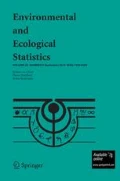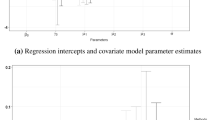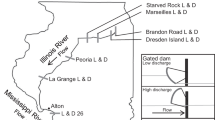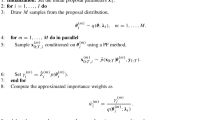Abstract
Hierarchical modeling of abundance in space or time using closed-population mark-recapture under heterogeneity (model \(\hbox {M}_{\text {h}}\)) presents two challenges: (i) finding a flexible likelihood in which abundance appears as an explicit parameter and (ii) fitting the hierarchical model for abundance. The first challenge arises because abundance not only indexes the population size, it also determines the dimension of the capture probabilities in heterogeneity models. A common approach is to use data augmentation to include these capture probabilities directly into the likelihood and fit the model using Bayesian inference via Markov chain Monte Carlo (MCMC). Two such examples of this approach are (i) explicit trans-dimensional MCMC, and (ii) superpopulation data augmentation. The superpopulation approach has the advantage of simple specification that is easily implemented in BUGS and related software. However, it reparameterizes the model so that abundance is no longer included, except as a derived quantity. This is a drawback when hierarchical models for abundance, or related parameters, are desired. Here, we analytically compare the two approaches and show that they are more closely related than might appear superficially. We exploit this relationship to specify the model in a way that allows us to include abundance as a parameter and that facilitates hierarchical modeling using readily available software such as BUGS. We use this approach to model trends in grizzly bear abundance in Yellowstone National Park from 1986 to 1998.


Similar content being viewed by others
References
Agresti A (1994) Simple capture-recapture models permitting unequal catchability and variable sampling effort. Biometrics 50:494–500
Bailey LL, Converse SJ, Kendall WL (2010) Bias, precision, and parameter redundancy in complex multistate models with unobservable states. Ecology 91(6):1598–1604
Bartolucci F, Forcina A (2001) Analysis of capture–recapture data with a Rasch-type model allowing for conditional dependence and multidimensionality. Biometrics 57(3):714–719
Bartolucci F, Forcina A (2006) A class of latent marginal models for capture–recapture data with continuous covariates. J Am Stat Assoc 101(474):786–794
Bartolucci F, Mira A, Scaccia L (2003) Answering two biological questions with a latent class model via MCMC applied to capture-recapture data. Appl Bayesian Stat Stud Biol Med 7
Boyce MS, MacKenzie DI, Manly BFJ, Haroldson MA, Moody D (2001) Negative binomial models for abundance estimation of multiple closed populations. J Wildl Manag 65:498–509
Brooks SP, Gelman A (1998) General methods for monitoring convergence of iterative simulations. J Comput Graph Stat 7(4):434–455
Burnham KP, Overton WS (1978) Estimation of the size of a closed population when capture probabilities vary among animals. Biometrika 65:625–633
Carlin B, Chib S (1995) Bayesian model choice via Markov chain Monte Carlo methods. J Royal Stat Soc Series B 57(3):473–484
Chib S (1995) Marginal likelihood from the Gibbs output. J Am Stat Assoc 90(432):1313–1321
Dempster AP, Laird NM, Rubin DB (1977) Maximum likelihood from incomplete data via the EM algorithm. J Royal Stat Soc B 39:1–38
Durban JW, Elston DA (2005) Mark-recapture with occasion and individual effects: abundance estimation through Bayesian model selection in a fixed dimensional parameter spaces. J Agric Biol Environ Stat 10:291–305
Farcomeni A, Tardella L (2010) Reference Bayesian methods for recapture models with heterogeneity. Test 19(1):187–208
Fienberg S, Johnson M, Junker B (1999) Classical multilevel and Bayesian approaches to population size estimation using multiple lists. J Royal Stat Soc Series A (Stat Soc) 162(3):383–405
Gelman A (2004) Parameterization and Bayesian modeling. J Am Stat Assoc 99(466):537–545
Gelman A (2006) Prior distributions for variance parameters in hierarchical models. Bayesian Anal 1:515–533
Gelman A, Carlin JB, Stern HS, Rubin DB (2004) Bayesian data analysis, 2nd edn. Chapman & Hall/CRC, London
Geman S, Geman D (1984) Stochastic relaxation, Gibbs distributions and the Bayesian restoration of images. IEEE Trans Patt Anal Mach Intell 6:721–741
Gimenez O, Choquet R (2010) Individual heterogeneity in studies on marked animals using numerical integration: capture-recapture mixed models. Ecology 91(4):951–957
Godsill SJ (2001) On the relationship between Markov chain Monte Carlo methods for model uncertainty. J Comput Graph Stat 10(2):230–248
Goodman LA (1974) Exploratory latent structure analysis using both identifiable and unidentifiable models. Biometrika 61(2):215–231
Green PJ (1995) Reversible jump Markov chain Monte Carlo computation and Bayesian model determination. Biometrika 82(4):711–732
Hook EB, Albright SG, Cross PK (1980) Use of Bernoulli census and log-linear methods for estimating the prevalence of spina bifida in livebirths and the completeness of vital record reports in New York State. Am J Epidemiol 112(6):750–758
King R, Brooks SP (2008) On the Bayesian estimation of a closed population size in the presence of heterogeneity and model uncertainty. Biometrics 64(3):816–824
Levine RA, Casella G (2001) Implementations of the Monte Carlo EM algorithm. J Comput Graph Stat 10(3):422–439
Link WA, Barker RJ (2010) Bayesian inference with ecological applications. Academic Press, London
Liu JS, Wu YN (1999) Parameter expansion for data augmentation. J Am Stat Assoc 94:1264–1274
Lunn D, Thomas A, Best N, Spiegelhalter D (2000) WinBUGS: a Bayesian modelling framework—concepts, structure, and extensibility. Stat Comput 10:325–337
MacKenzie DI, Nichols JD, Lachman GB, Droege S, Royle JA, Langtimm C (2002) Estimating site occupancy rates when detection probabilities are less than one. Ecology 83:2248–2255
Madigan D, York J (1997) Bayesian methods for estimation of the size of a closed population. Biometrika 84(1):19–31
Otis DL, Burnham KP, White GC, Anderson DR (1978) Statistical inference from capture data on closed animal populations. Wildl Monogr 62:1–135
Plummer M (2003) JAGS: a program for analysis of Bayesian graphical models using Gibbs sampling. In: Proceedings of the 3rd international workshop on distributed statistical computing, Vienna, Austria.
Pollock KH (1982) A capture–recapture design robust to unequal probability of capture. J Wildl Manag 46(3):752–757
Royle JA (2008) Modeling individual effects in the Cormack-Jolly-Seber model: a state-space formulation. Biometrics 64(2):364–370
Royle JA, Dorazio RM (2012) Parameter-expanded data augmentation for Bayesian analysis of capture–recapture models. J Ornithol 152:521–537
Royle JA, Dorazio RM, Link WA (2007) Analysis of multinomial models with unknown index using data augmentation. J Comput Graph Stat 16:67–85
Royle J, Dorazio R (2008) Hierarchical modeling and inference in ecology: the analysis of data from populations, metapopulations and communities. Academic Press, London
Sanathanan L (1972) Estimating the size of a multinomial population. Ann Math Stat 43(1):142–152
Schofield MR, Barker RJ (2011) Full open population capture–recapture models with individual covariates. J Agric Biol Environ Stat 16:253–268
Sisson SA (2005) Transdimensional Markov chains. J Am Stat Assoc 100(471):1077–1089
Stanghellini E, van der Heijden PGM (2004) A multiple-record systems estimation method that takes observed and unobserved heterogeneity into account. Biometrics 60(2):510–516
Tardella L (2002) A new Bayesian method for nonparametric capture-recapture models in presence of heterogeneity. Biometrika 89(4):807–817
Acknowledgments
M.R.S. was partially funded by NSF Grants Nos. 0934516 and 0814194.
Author information
Authors and Affiliations
Corresponding author
Additional information
Handling Editor: Pierre Dutilleul.
Electronic supplementary material
Below is the link to the electronic supplementary material.
Rights and permissions
About this article
Cite this article
Schofield, M.R., Barker, R.J. Hierarchical modeling of abundance in closed population capture–recapture models under heterogeneity. Environ Ecol Stat 21, 435–451 (2014). https://doi.org/10.1007/s10651-013-0262-3
Received:
Revised:
Published:
Issue Date:
DOI: https://doi.org/10.1007/s10651-013-0262-3




